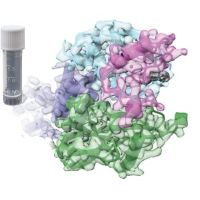Specification
| Description | Recombinant protein from the full-length sequence of Homo sapiens SEC14 like lipid binding 2 (SEC14L2), transcript variant 1 (NM_012429). |
| Organism | Homo sapiens (Human) |
| Expression Host | Human Cells |
| Tag Info | His or DYKDDDDK. Please contact us if you need further information or require specific designed tag. |
| Purity | Greater than 90% by SDS-PAGE gel |
| Uniprot ID | O76054 |
| Entry Name | S14L2_HUMAN |
| Gene Names | SEC14L2 C22orf6 KIAA1186 KIAA1658 |
| Alternative Gene Names | C22orf6 KIAA1186 KIAA1658 |
| Alternative Protein Names | SEC14-like protein 2 (Alpha-tocopherol-associated protein) (TAP) (hTAP) (Squalene transfer protein) (Supernatant protein factor) (SPF) |
| Application | Antigens, Western, ELISA and other in vitro binding or in vivo functional assays, and protein-protein interaction studies; For research & development use only! |
| Buffer | Purified protein formulated in a sterile solution of PBS buffer, pH7.2, without any preservatives |
| Endotoxin | Endotoxin level is < 0.1 ng/µg of protein (<1EU /µg) |
| Length | 403 |
| Molecular Weight(Da) | 46145 |
| Protein Sequence | (The sequence of expressed protein may have some variation from the sequence shown below. Please contact us for the exact sequence.) MSGRVGDLSPRQKEALAKFRENVQDVLPALPNPDDYFLLRWLRARSFDLQKSEAMLRKHVEFRKQKDIDNIISWQPPEVIQQYLSGGMCGYDLDGCPVWYDIIGPLDAKGLLFSASKQDLLRTKMRECELLLQECAHQTTKLGRKVETITIIYDCEGLGLKHLWKPAVEAYGEFLCMFEENYPETLKRLFVVKAPKLFPVAYNLIKPFLSEDTRKKIMVLGANWKEVLLKHISPDQVPVEYGGTMTDPDGNPKCKSKINYGGDIPRKYYVRDQVKQQYEHSVQISRGSSHQVEYEILFPGCVLRWQFMSDGADVGFGIFLKTKMGERQRAGEMTEVLPNQRYNSHLVPEDGTLTCSDPGIYVLRFDNTYSFIHAKKVNFTVEVLLPDKASEEKMKQLGAGTPK |
Background
| Function | FUNCTION: Carrier protein. Binds to some hydrophobic molecules and promotes their transfer between the different cellular sites. Binds with high affinity to alpha-tocopherol. Also binds with a weaker affinity to other tocopherols and to tocotrienols. May have a transcriptional activatory activity via its association with alpha-tocopherol. Probably recognizes and binds some squalene structure, suggesting that it may regulate cholesterol biosynthesis by increasing the transfer of squalene to a metabolic active pool in the cell. |
| Pathway | |
| Protein Families | |
| Tissue Specificity | Widely expressed. Strong expression in liver, brain and prostate. {ECO:0000269|PubMed:10829015}. |
QC Data
| Note | Please contact us for QC Data |
| Product Image (Reference Only) |  |

